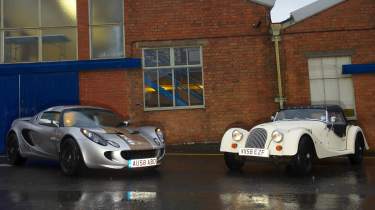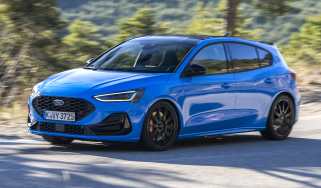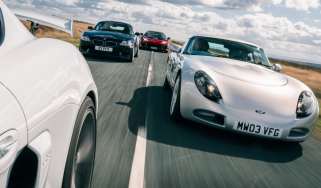Morgan 4/4 Sport v Lotus Eco Elise
John Simister compares a Morgan and Lotus Eco Elise and argues that 'green' motoring is more than skin deep
Unlikely testfellows, these. Or are they? Parked at Morgan's heritage-marinaded factory in Malvern Link, Worcestershire on the least convertible-friendly day of 2009 to date, the Lotus Eco Elise is attracting a lot of attention. There's that natural-materials thing, for a start. The people at Morgan are used to working with wood and leather, for the wood-framed bodies of the 'classic' Morgan have barely changed since the 1930s. But what's this lurking under the clear gel-coat of the experimental Elise's central stripe? Hemp. There's no glassfibre here; the bodyshell is made from plant fibre-reinforced resin. Gazes move from outside to inside. Hemp-shelled seats with undyed woollen fabric. Sisal carpets. Wooden knobs for gear lever and handbrake. Then up to the hardtop roof, hemp-reinforced resin again, which contains a pair of photovoltaic solar panels to help keep the battery charged. Not any solar panels, though; these are specially made to match the curve of the roof panel. And the whole lot is finished in water-based paints and lacquers, where paint is needed. There is only one Eco Elise, although the hemp bodywork could reach production if it proves able to pass crash tests, which Lotus thinks it will. So it's slightly precious. That said, it's still an Elise. And that makes it hard to drive without having a good time. This one weighs about 32kg less than a regular Elise S, helped by extra-light wheels (15.8kg saved) and even a lightweight stereo (1.5kg saved). Being mechanically an S, with the 1.8-litre Toyota engine in gentle 134bhp tune, it's not massively fast, but on my snow- and slush-laden drive through the Cotswolds and up to Malvern, where delicacy of power delivery trumps muscularity, it's plenty fast enough. The precision, intimacy and controllability of an Elise are your greatest allies in conditions like these. I find myself overtaking cars time and again, cars whose drivers can't feel what's happening underneath them so they're scared and stay slow. In the Lotus I can feel everything so I know what's possible and what is not, and so what if the tail slithers as I take another roundabout? It's irresistible; the only existing Eco Elise just keeps egging me on. Just don’t crash it, Simister. Surely, I think, this is the way sports cars will have to be: minimalist in mass and muscular extravagance, made of 'sustainable' – oh, how that word is rammed down our throats! – materials, low in energy use. Not that the Toyota engine is great at minimising CO2, it must be said (196g/km in a standard Elise S). No doubt Lotus is working on that. But there's more than one way to make an eco-friendly sports car, which is why we're at Malvern. In conversation recently, Charles Morgan pointed out to me that his 4/4 Sport fits the modern eco-vogue rather well. It's analagous to the way the old Rolls-Royce/Bentley V8 has serendiptously turned out to be very suitable for today's low-emissions engine systems, even though its particular design of combustion chamber was hardly created with that in mind. Morgans having been around forever, no-one thinks of them as being especially lightweight. That's because they weren't back then, but the 795kg of a 4/4 Sport is featherweight by today's standards, lighter even than the 828kg Eco Elise. Yet the Morgan conforms to all the modern rules that it needs to, and with its modern engine – a 1.6-litre, 115bhp Ford Sigma unit, the one also found in basic Caterhams in which it has supplanted the K-series – it can turn surprising CO2 figures. It's homologated at 140g/km, but Morgan's own tests run to the same strictures have seen as little as 135g/km. Yet its pace is lively enough, with 62mph in eight seconds, and if the 115mph top speed sounds low you only have to look at the Morgan's aerodynamic trouble. Besides, pure pace is not what a Morgan is about even if the Rover V8-engined Plus Eight was, for a time in the 1960s, the UK's fastest-accelerating production car. Step out of the ultra-modern Elise (can the design really be 12 years old?) and into the Morgan, and you'll be shocked. I'm quite used to post-vintage cars, having owned a couple and driven many, but to be confronted with such familiarity in a car fresh from the factory is almost surreal. And it's made more so by the fitment in today's classic Morgans of visually suitable instruments and switchgear, with less sign (column stalks excepted) of modern, mass-produced plastic than a Morgan cockpit displayed when I last encountered one, about 12 years ago. This is a Morgan in its simplest, purest form. It has black wire wheels, a dashboard in body colour beneath the tan leather padding, no bumpers. No spare wheel, either, just a circle on the tail to mark where it once was. Outside, it looks much as Morgans have looked since the radiator grille went from flat to rounded in the 1950s, but nowadays all the bodywork is in aluminium, the wings are 'superformed' by machine rather than hand-beaten, and the paint is both water-based and mirror-like. The rear lights are still the same as those worn by the souped-up Imps I used to own, though. I must be mad driving a Morgan on a day like today, but here goes. The hood is up, but water pours in until I feed the edge over the side window. Three tiny windscreen wipers dance in unison and the woodrim Moto-Lita steering wheel's proximity, despite its bizarre reverse dishing, causes my arms to bend at double their angle in the Elise. Is that to help me cope with the lack of power steering? Floor-hinged clutch pedal down, aluminium gear-knob prodded into first with a disappointingly vague, springy movement. Fly-off handbrake flown off, away we go as I wonder if I should have exhumed my flying jacket. Ah, this feels familiar – yet it doesn't. Morgans have always put you in the dynamic picture, but with the image has come a lot of interference. That's inevitable with a floppy chassis and stiff suspension, both conspiring to make the dampers' tasks harder and the wheels unlikely to stay in firm contact with a bumpy road. As for wet grip, just hang on and hope. But much has happened since I last drove a primordial Morgan. Dampers and tyres have improved greatly, and even a Morgan can benefit. The steering is proving surprisingly light, its subtlety of feel modulated on the carrier wave of kickback (think how AM radio works). On these slithery roads the 4/4 Sport finds unexpected grip, and the dampers control the skittering while letting the suspension work enough to mask the worst bumps. In isolation it's good, involving fun and more capable than you'd think. The engine is quite a willing thing, too, despite longish gearing, but it's hardly sonorous. I fight with the press-studs and poppers and stash the hood away. Now the Morgan is in its element and I'm in the elements, a chunk of ice falling from a tree and smiting my right eye. Of course the 4/4 Sport is inept by most modern standards, and Morgan knows that perfectly well. But that's not the point; being transported out of time is. Then I get back into the Elise. It's an Exocet by comparison, suddenly impossibly keen and quick and focused and on-message, refusing to be distracted, centred on one-to-one communication. It's breathtaking, and a very different kind of entertainment. You can't say it's more fun, but you'll have the fun more of the time. Ponder this, though. Morgan, 100 years old this year and one of the last wholly British-owned car companies, is a lean, efficient, environmentally-savvy company making cars with local labour and sustainable local materials. Its cheapest car is light and fuel-efficient. Sounds remarkably like Lotus, then. But until elements of the Eco Elise make production, and the engine becomes more efficient, the relic from Malvern wins the green prize in 2009. Who'd have thought it?
Specifications
| LOTUS ECO ELISE | |
| Engine | 4cyl, 1794cc, dohc 16v |
| Max power | 134bhp @ 6200rpm |
| Max torque | 127lb ft @ 4200rpm |
| Top speed | 127mph (claimed) |
| 0-62mph | 6.1sec (claimed) |
| Price | £25,712 (standard Elise S) |
| MORGAN 4/4 SPORT | |
| Engine 4cyl | 1595cc, dohc 16v |
| Max power | 115bhp @ 6350rpm |
| Max torque | 97lb ft @ 5750rpm |
| Top speed | 115mph (claimed) |
| 0-62mph | 8.0sec (claimed) |
| Price | £25,473 |



